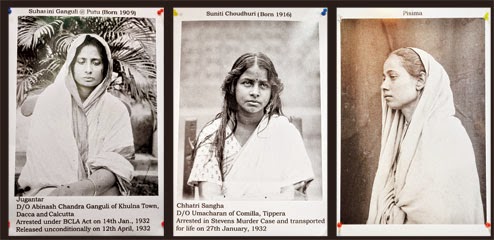| Surya Sen | |
|---|---|
|
Surya Sen
| |
| Born | Suryakumar Sen 22 March 1894 Chittagong, Bengal Presidency, British India (now Bangladesh) |
| Died | 12 January 1934 (aged 39) Chittagong, Bengal Presidency, British India (now Bangladesh) |
| Ethnicity | Bengali |
| Organization | Indian National Congress |
| Known for | Chittagong armoury raid |
| Movement | Indian Independence movement |
Early life
Sen was born on 22 March 1894 at Noapara, under Raozan upazilla in Chittagong. His father Ramaniranjan Sen was a teacher. In 1916 when he was a B.A. student in Behrampore College he learned about Indian freedom movement from one of his teachers, Prof Satish Chandra . Chakrabarty.who initiated him in revolutionary hymn. He felt attracted towards revolutionary ideals and joined a revolutionary organization Anushilan Samity. After completing his studies he returned to Chittagong in 1918 and joined as a teacher at National school, Nandankanan . At that time, Indian National Congress was the most prominent political party there.
He participated in Non-Cooperation movement launched by Gandhiji and organised youth forum. But due to the failure of Non-Cooperation movement, revolutionary activities were again started. He organised a secret organisation namely "Satyashram". At this time he organised several revolutionary activities. He looted Rupees 23 thousand from Rail company on 20.Dec 1923, his followers forcibly stopped the rail near Kakori station in Aug 1925, attempted for assassination of ferocious police commissioner Tegart in Kolkata in 1924 and failed. He was arrested in 1926 and was released in 1928 and formed a Chittagong Branch of Indian Republican Armyto fight for Independence.Many muslims were in his organisation.
He participated in Non-Cooperation movement launched by Gandhiji and organised youth forum. But due to the failure of Non-Cooperation movement, revolutionary activities were again started. He organised a secret organisation namely "Satyashram". At this time he organised several revolutionary activities. He looted Rupees 23 thousand from Rail company on 20.Dec 1923, his followers forcibly stopped the rail near Kakori station in Aug 1925, attempted for assassination of ferocious police commissioner Tegart in Kolkata in 1924 and failed. He was arrested in 1926 and was released in 1928 and formed a Chittagong Branch of Indian Republican Armyto fight for Independence.Many muslims were in his organisation.
Chittagong armoury raid
Mainly by the plan of ganesh Ghosh , Surya Sen led a group of 65 revolutionaries with few revolvers and some ordinary Guns on 18 April 1930 to raid the armoury of police and auxiliary forces from the Chittagong armoury. The plan was elaborate and included seizing of arms from the armoury as well as destruction of communication system of the city (including telephone, telegraph and railway), thereby isolating Chittagong from the rest of British India. However, although the group could loot the arms, they failed to get the ammunition. They hoisted the national flag on the premises of the armoury, and then escaped. The senior British army officers fled away to the anchored ship. Chittagong city was freed for 48 hours. A few days later, a large fraction of the revolutionary group was cornered in the nearby Jalalabad hills by the British troops. In the ensuing fight, twelve revolutionaries died, many were arrested, while some managed to flee, including Surya Sen.
Arrest and death
Surya Sen stayed in hiding, and kept moving from one place to another. Sometimes he took up a job as a workman, a farmer, a priest, a house worker or even as a pious Muslim. This is how he avoided being captured by the British. He once hid in the house of a man called Netra Sen. Either because of greed of money, or out of jealousy or maybe both, Netra Sen informed the British that Surya Sen had taken asylum at his house, and the police came and captured him in February 1933. This is how India’s supreme freedom fighting hero was arrested. Before Netra Sen could be rewarded by the British, a revolutionary came into his house and beheaded him with a long knife, called 'daa'. As Netra Sen's wife was a big supporter of Surya Sen, she never disclosed the name of the revolutionary who killed Netra Sen. Before Surya Sen was hanged, he was brutally tortured by the British. The British executioners broke all his teeth with a hammer, and pulled out all his nails. They broke all his limbs and joints. He was dragged to the rope unconscious. His last letter was written to his friends and said: “Death is knocking at my door. My mind is flying away towards eternity ...At such a pleasant, at such a grave, at such a solemn moment, what shall I leave behind you? Only one thing, that is my dream, a golden dream-the dream of Free India.... Never forget the 18th of April,1930, the day of the eastern Rebellion in Chittagong... Write in red letters in the core of your hearts the names of the patriots who have sacrificed their lives at the altar of India’s freedom.
In popular media
A film named Khelein Hum Jee Jaan Sey was made on the life of Surya Sen directed by Ashutosh Gowariker. Chittagong (film) made by Bedabrata Pain which released in 2012 was based on the story of the armoury raid.








 Subodh Chandra Basu Mallik
Subodh Chandra Basu Mallik
 Notes for Subodh Chandra Basu Mallik:
Notes for Subodh Chandra Basu Mallik:

